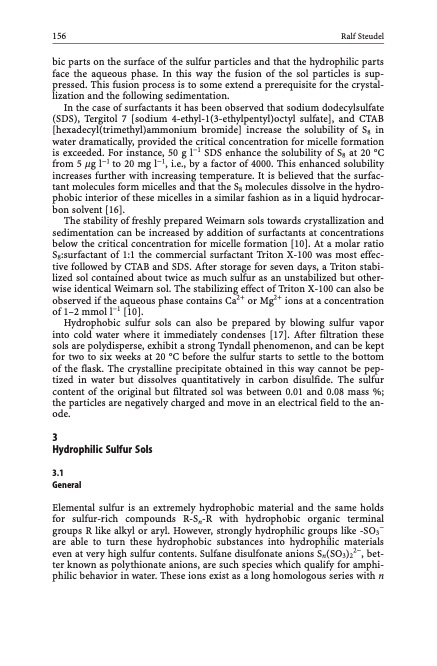
PDF Publication Title:
Text from PDF Page: 166
156 Ralf Steudel bic parts on the surface of the sulfur particles and that the hydrophilic parts face the aqueous phase. In this way the fusion of the sol particles is sup- pressed. This fusion process is to some extend a prerequisite for the crystal- lization and the following sedimentation. In the case of surfactants it has been observed that sodium dodecylsulfate (SDS), Tergitol 7 [sodium 4-ethyl-1(3-ethylpentyl)octyl sulfate], and CTAB [hexadecyl(trimethyl)ammonium bromide] increase the solubility of S8 in water dramatically, provided the critical concentration for micelle formation is exceeded. For instance, 50 g l1 SDS enhance the solubility of S8 at 20 C from 5 mg l1 to 20 mg l1, i.e., by a factor of 4000. This enhanced solubility increases further with increasing temperature. It is believed that the surfac- tant molecules form micelles and that the S8 molecules dissolve in the hydro- phobic interior of these micelles in a similar fashion as in a liquid hydrocar- bon solvent [16]. The stability of freshly prepared Weimarn sols towards crystallization and sedimentation can be increased by addition of surfactants at concentrations below the critical concentration for micelle formation [10]. At a molar ratio S8:surfactant of 1:1 the commercial surfactant Triton X-100 was most effec- tive followed by CTAB and SDS. After storage for seven days, a Triton stabi- lized sol contained about twice as much sulfur as an unstabilized but other- wise identical Weimarn sol. The stabilizing effect of Triton X-100 can also be observed if the aqueous phase contains Ca2+ or Mg2+ ions at a concentration of 1–2 mmol l1 [10]. Hydrophobic sulfur sols can also be prepared by blowing sulfur vapor into cold water where it immediately condenses [17]. After filtration these sols are polydisperse, exhibit a strong Tyndall phenomenon, and can be kept for two to six weeks at 20 C before the sulfur starts to settle to the bottom of the flask. The crystalline precipitate obtained in this way cannot be pep- tized in water but dissolves quantitatively in carbon disulfide. The sulfur content of the original but filtrated sol was between 0.01 and 0.08 mass %; the particles are negatively charged and move in an electrical field to the an- ode. 3 Hydrophilic Sulfur Sols 3.1 General Elemental sulfur is an extremely hydrophobic material and the same holds for sulfur-rich compounds R-Sn-R with hydrophobic organic terminal groups R like alkyl or aryl. However, strongly hydrophilic groups like -SO3 are able to turn these hydrophobic substances into hydrophilic materials even at very high sulfur contents. Sulfane disulfonate anions Sn(SO3)22, bet- ter known as polythionate anions, are such species which qualify for amphi- philic behavior in water. These ions exist as a long homologous series with nPDF Image | Topics in Current Chemistry

PDF Search Title:
Topics in Current ChemistryOriginal File Name Searched:
Elemental-Sulfur-und-Sulfur-Rich-Compounds-I.pdfDIY PDF Search: Google It | Yahoo | Bing
Sulfur Deposition on Carbon Nanofibers using Supercritical CO2 Sulfur Deposition on Carbon Nanofibers using Supercritical CO2. Gamma sulfur also known as mother of pearl sulfur and nacreous sulfur... More Info
CO2 Organic Rankine Cycle Experimenter Platform The supercritical CO2 phase change system is both a heat pump and organic rankine cycle which can be used for those purposes and as a supercritical extractor for advanced subcritical and supercritical extraction technology. Uses include producing nanoparticles, precious metal CO2 extraction, lithium battery recycling, and other applications... More Info
| CONTACT TEL: 608-238-6001 Email: greg@infinityturbine.com | RSS | AMP |